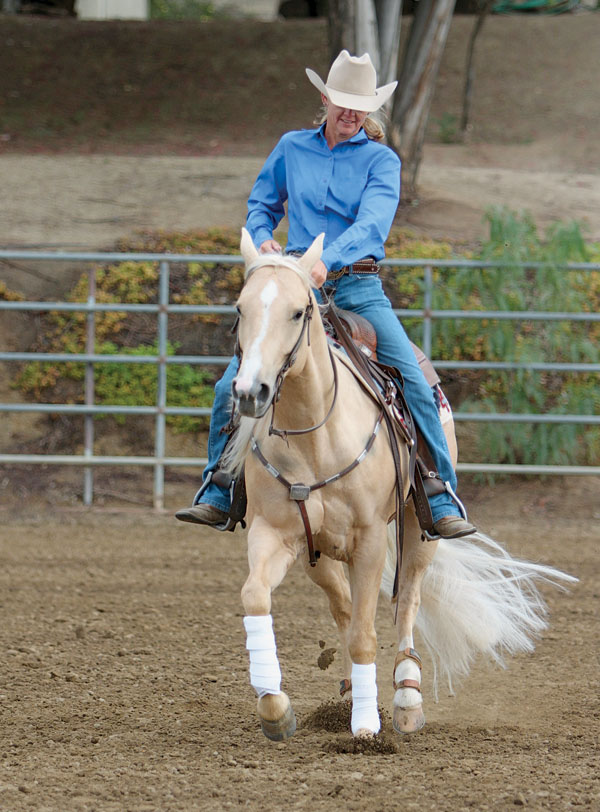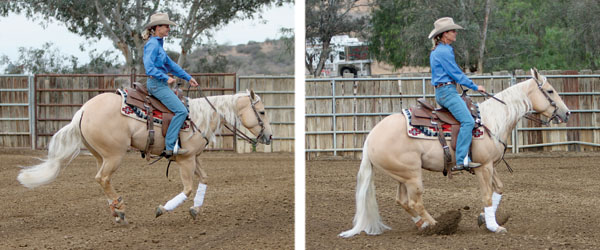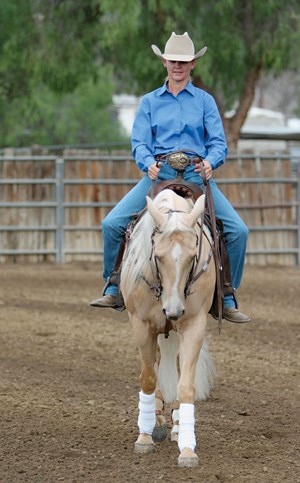Q My horse slips out of lead behind when we lope large, fast circles. What can I do at home to work on this problem, and what should I do in the show pen to prevent it from happening?

Mikayla Brown, Kansas
A It’s frustrating when a horse regularly falls out of lead during fast circles, especially if you compete and get hit with a penalty every time it happens.
I suggest starting with a hard look at yourself before you blame your horse for this problem. Are you riding centered above your horse? If not, your leaning can make him lean, too, predisposing him to fall out of lead. Do you anticipate the mistake?
Anticipation can will it to happen. Are you overcorrecting a smaller problem? You also can cause lead problems by pushing your horse crooked the other way by moving his hip over too far, or by picking up his shoulder too much.
Think about using both legs and centering your hands. Even if your horse is uneven, you should be centered. It’ll lead your horse to correct himself, because the only way he’ll find the middle (and straightness) is if you’re there.
Once you’re sure that you’re not the cause of the problem, here are three other measures to take.
Get Squared-Up
Be sure that your horse is loping squarely between your hands and legs. By that, I mean his shoulders are up, his hindquarters are underneath him, and his head and neck are in alignment with his spine.

You want the horse right between your reins and legs. It’s something you’ll feel. Lift your rein hand in the center, over the saddle horn, and place pressure on your horse’s sides until you feel like there’s the same amount of horse on each side of an invisible line that goes down your horse’s spine. When you square up, he’ll place less pressure on the reins, so you might even feel the weight come off your hands.
You don’t want to see more of the horse on either side of the reins. Instead, look for an even amount of horse under your hands. You’ll probably need to look down to get the visual at first, but then you’ll be able to feel it. Until you get the feel, just glance down; don’t stare. You need to look where you’re going.
With his body square underneath you, it’s harder for your horse, and you, to lose control of his hips, even when traveling with speed. If he’s not leaning into the circle, he’s less apt to fall out of lead behind.
Stop and Start Over
If your horse falls out of lead behind, make a steady, straight stop—don’t slam him into the ground, which could break his confidence about stopping. Rather, draw him into the ground for a soft, slow stop. Once he’s stopped, get your horse squared up with the tips I mentioned in the previous section, and then walk or trot forward. If your horse still isn’t quite square from the tip of his ears to the end of his tail, trot a few circles to work on that straightness. If he can’t maintain straightness at a trot, he certainly can’t do it at a lope.
Once your horse is straight, ask for a lope again. Then build speed, and see what happens. If your horse falls out of lead again, start the drill over and repeat until he can complete a circle without changing leads behind.
Move His Hip
Once you’ve achieved straightness, continue working at a walk or trot. Use your outside foot, placed behind the cinch, to push your horse’s hips to the inside of the circle as you come through the middle of the arena, almost sidepassing to the inside of the circle. This helps your horse listen to your outside leg. Success with this drill means that you could feel your horse start to change leads behind, but put your outside leg on and offer support to keep him in lead.

As a bonus, you’ll achieve better control over your horse’s body, which is always beneficial. But I do caution: Don’t overdo this exercise, because you don’t want to swap your horse’s leaning tendencies in the opposite direction.
Check Your Speed
Some horses just can’t handle a high rate of speed, whether due to conformation or temperament. You must know your horse and accept his limitations. If this is the case for your horse, in the show pen I suggest playing it safe when it comes to your fast circles. Instead of trying to earn points in those maneuvers, work to stay clean and out of the penalty box.
Kristi Berg, Temecula, California, is a lifelong horsewoman and native Californian. She’s worked for top trainers, including Todd Crawford and Pete Kyle, and now owns and operates Berg Performance Horses with her husband, Mike. The pair coaches non-pro riders and shows open horses in reining and cow horse events.




